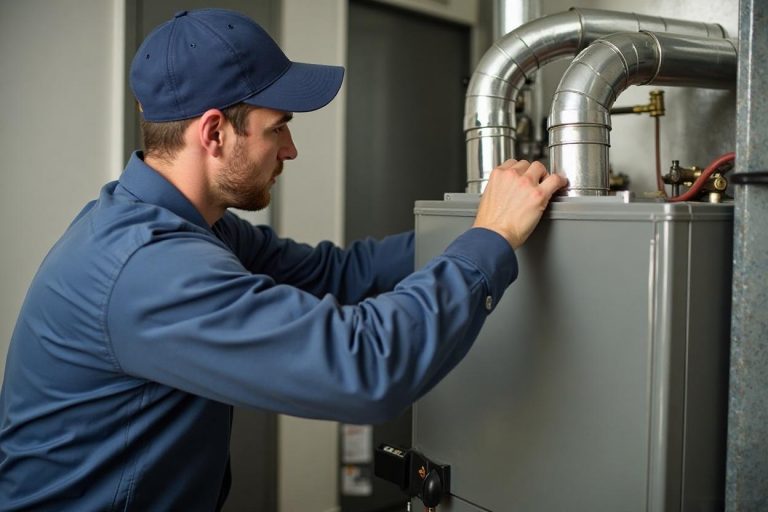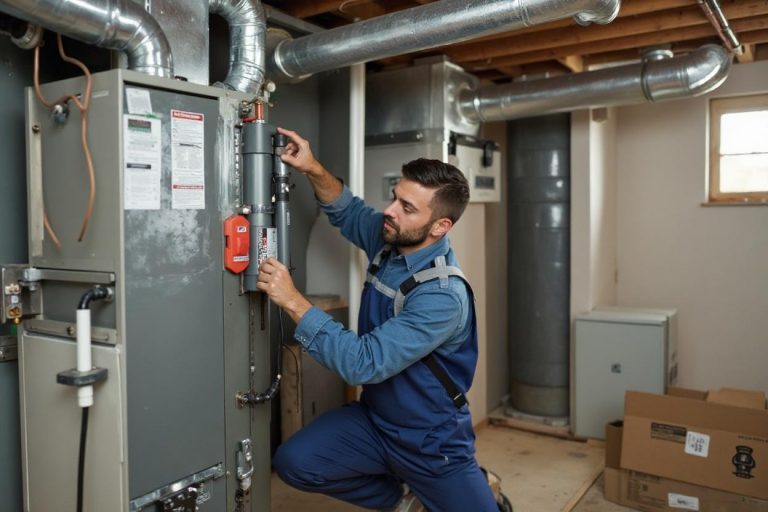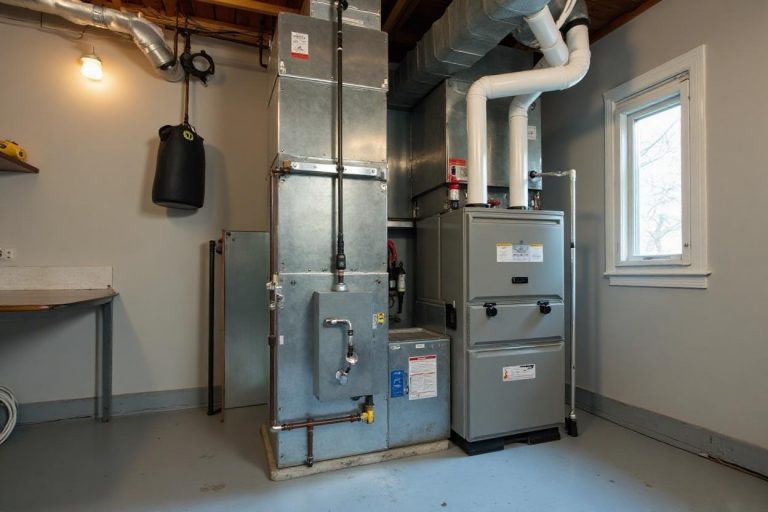Gas Furnace Maintenance 101: Essential Tasks, Service Frequency, and When to Call a Pro
Natural gas furnace maintenance pays back in lower energy bills, safer operation, and fewer mid-winter breakdowns. In Middlefield, CT, where a January cold snap can stick around for days, a clean and tuned furnace matters. Homeowners often ask the same three questions: what they can do themselves, how often service is needed, and which warning signs mean a professional visit. This guide covers all three with clear steps and local context.
Why maintenance matters in Middlefield homes
Small issues turn into bigger repairs under load. A slightly dirty flame sensor becomes a no-heat call during a single-digit night. A loose condensate hose freezes and shuts down a high-efficiency model when it runs nonstop. Maintenance prevents those winter failures by addressing wear before it becomes a breakdown. It also keeps combustion clean, which protects the heat exchanger and reduces carbon monoxide risk.
There is a money angle too. A tuned furnace runs smoother and cycles less. Homeowners in Middlefield who keep up with service typically see 5 to 15 percent savings on gas usage compared with neglected units. That spread comes from tighter combustion, correct gas pressure, and proper airflow across the heat exchanger.
What a homeowner can safely do
A few simple habits go a long way. The goal is to support airflow, keep sensors clean, and spot changes early.
Change the air filter on time. Most homes in Middlefield do well on a 60 to 90-day schedule with standard 1-inch filters. Homes with pets or drywall dust after a renovation may need a 30-day cycle until the dust clears. If the furnace uses a 4- or 5-inch media filter, check it at 90 days and replace it at 6 to 12 months based on appearance. A starved blower stresses the motor, overheats the heat exchanger, and drives up gas use.
Keep supply and return vents open. Closing many registers to “push heat” to other rooms creates static pressure the blower cannot handle. That pressure trips safeties and shortens motor life. Keep furniture, curtains, and rugs clear of return grilles, especially in older Middlefield colonials where returns can be undersized.
Vacuum the furnace area. Dust and pet hair collect around the blower door and get pulled into the cabinet. With the furnace off at the switch, vacuum the floor and the cabinet exterior. Do not open the burner compartment unless trained.
Check the thermostat basics. Replace thermostat batteries once a year if it uses them. Make sure the “heat” mode is active and the fan is in “auto.” If there is a smart thermostat, verify software updates and confirm the temperature schedule matches actual use.
Look and listen monthly. A steady blue flame, a smooth blower ramp-up, and no burnt smell after the first minute all point to normal operation. Short cycling, rattles, or a sharp metallic smell call for a technician.
These tasks are safe and effective. They do not replace a professional tune-up for combustion checks, gas adjustments, and internal cleaning.
What a professional tune-up includes
Natural gas furnace maintenance by a licensed technician focuses on combustion safety, airflow, and electrical reliability. The specifics vary with equipment age and efficiency rating, yet the core process is consistent.
The visit begins with a safety check. The technician verifies the shutoff switch, checks for gas leaks at unions and the gas valve, and inspects the flue. On high-efficiency units, the PVC vent and intake are inspected for slope, gaps, and ice risk. On metal chimneys, draft and liner condition get attention.
Combustion analysis follows. Using a combustion analyzer, the technician measures oxygen, carbon dioxide, and carbon monoxide in the flue. These readings tell whether gas pressure, primary air, and burner performance are correct. Adjustments are made at the gas valve within manufacturer specs. On most furnaces, manifold gas pressure lands in the 3.2 to 3.8 inches water column range for natural gas, but the exact target depends on the model sticker.

Burner and flame sensor care come next. Burners collect rust and dust that distort the flame. The tech removes and cleans them if needed. The flame sensor gets light cleaning to restore reliable flame proving. An igniter is inspected for cracks and correct resistance. These steps are small but they prevent lockouts on cold starts.
Airflow is verified. The blower wheel accumulates fine dust that reduces airflow and spikes energy use. If the wheel is dirty, it is removed and cleaned. Static pressure is measured across the system to confirm the ductwork and filter allow design airflow. High static pressure is common in older Middlefield homes with added rooms and unchanged ducts; the technician may recommend duct adjustments or a different filter type to reduce restriction.
Electrical tests round it out. The technician checks voltage, amperage, and wiring connections at the blower motor, inducer motor, and control board. Capacitors are tested and replaced if weak. Safety switches are tested for proper trip and reset behavior. On modulating or two-stage furnaces, the control logic is checked for correct staging and fan profiles.
High-efficiency condensate lines are flushed and traps cleaned. Slime or debris in traps can shut a system down, and long, flat runs can freeze against exterior walls in local cold snaps. Where needed, the tech adds heat tape or reroutes lines for better slope.
This work shows up later as quieter starts, steadier temperatures, and normal burner cycles. It also extends heat exchanger life by keeping temperatures within design range.
Service frequency that makes sense
Most Middlefield homes benefit from one professional maintenance visit per heating season. Late summer or early fall is ideal. The furnace is easy to access, parts are in stock, and any issues are resolved before the first cold front.
Homes with long run times or indoor air challenges may need more attention. If there are two shedding pets, a woodworking hobby, or ongoing renovations, the filter schedule should tighten and a mid-season check may be wise. High-efficiency furnaces with long PVC runs or complex zoning also benefit from a spring check to confirm the condensate system is clear after heavy winter use.
If the furnace is brand-new, follow the manufacturer’s schedule to protect the warranty. Most require annual service documentation. For equipment Check out the post right here older than 12 to 15 years, annual service becomes even more critical because parts age at different rates and small drift in combustion or airflow has a larger impact.
Signs that call for a professional
Some symptoms point straight to the need for a trained set of eyes and tools. Quick action can prevent a no-heat situation or a safety hazard.
- Repeated short cycling where the furnace starts and stops within a few minutes.
- A yellow or flickering flame instead of steady blue.
- Burning or electrical smells beyond the first minute of a season’s first run.
- Water around the furnace cabinet, especially on high-efficiency models.
- Unusual noises like grinding, loud humming, or whistling at registers.
If carbon monoxide alarms activate, leave the home and call for emergency service. Do not restart the furnace until it has been inspected.
This is the first of the two allowed lists.
A quick look at common Middlefield setups
Middlefield has a mix of mid-efficiency 80 percent furnaces with metal flues and 90 to 97 percent condensing units vented in PVC. Ranches often hide furnaces in tight basements, and saltbox or colonial homes may have equipment in utility rooms near exterior walls. These layouts influence maintenance.
Tight basements need good return paths and clearances. If the furnace door is hard to remove due to shelving or stored items, the area needs to be cleared for service. Furnaces near exterior walls face colder conditions, which makes condensate freezing more likely. A pro may add heat cable on exposed condensate lines or re-route to a heated interior drain path.

Older homes with original ductwork sometimes run high static pressure. That shows up as loud airflow, hot supply ducts near the furnace, cold rooms at the ends, and limit trips. Solving this can be as simple as using a deeper pleated media filter and sealing duct leaks, or as involved as adding return capacity. The maintenance visit is the right time to gather data and plan a fix.
The difference maintenance makes on bills and comfort
Clean burners and correct gas pressure improve combustion efficiency. A tuned furnace reaches set temperature quicker and cycles less, which reduces gas consumption by a noticeable margin over a season. Homeowners often report a quieter start-up and more stable room temperatures after service. Rooms at the end of longer runs feel closer to the hallway thermostat reading once airflow is corrected and the blower wheel is cleaned.
There is a reliability dividend too. Items like cracked igniters, weak capacitors, and restricted condensate traps show early signs during a tune-up. Replacing a $20 to $60 capacitor in October often avoids a no-heat call on a January night. Catching a hairline crack in a hot surface igniter prevents a lockout on a cold start.
DIY boundaries: what not to touch
Homeowners handle filters, thermostat batteries, and basic cleaning. They should not adjust gas valves, open sealed combustion compartments, or bypass safety switches. Combustion analysis needs instruments and training. Gas leaks, flue issues, and cracked heat exchangers demand professional diagnosis. Spraying household cleaners inside the burner or blower compartments can damage sensors and boards.
If in doubt, call for advice before attempting a fix. Most problems present in patterns. A technician who services Middlefield equipment daily can often recognize those patterns from a short description and guide the next step.

Seasonality in Connecticut and how to plan
The first real cold stretch in Middlesex County can hit in late November. Furnaces that sat quiet all spring and summer collect dust on flame sensors and burners. That is why early fall scheduling works well. It avoids the rush that comes with the first hard freeze, and parts are easier to get. If a furnace ever trips a pressure switch or a limit switch during a cold spell, note the exact conditions, including outdoor temperature and thermostat setpoint. That information helps the technician reproduce and solve the issue.
High-efficiency models with long intake runs can pull in frost or debris during windy snow events. After a storm, it is worth a quick walk outside to confirm the PVC intake and exhaust are clear of snow and leaves. Keep a three-foot clear area around those terminations.
Safety notes that matter
Carbon monoxide is odorless. Working CO detectors on each level and outside sleeping areas are non-negotiable in homes with gas furnaces. Test them monthly and replace units that reach the end of their service life, usually 5 to 7 years depending on the model. During maintenance, the technician should test for CO at the furnace and at supply registers under load.
Gas leaks are uncommon yet serious. If there is a sulfur-like odor near the furnace or gas meter, avoid switches and open flames, leave the home, and contact the gas utility and a qualified HVAC company. Annual service includes leak checks at accessible joints.
Backdrafting at atmospheric flues can occur in tight homes or when exhaust fans and dryers run. The maintenance visit should include a draft test with those appliances operating to confirm safe venting. If backdrafting appears, solutions range from adding combustion air to upgrading the venting strategy.
What a service appointment looks like with Direct Home Services
Local knowledge shortens the path to a reliable fix. Technicians who work in Middlefield daily know the common furnace models in the area, the typical duct layouts, and the impact of our winters. A standard maintenance visit includes scheduling at a time that works for the household, a clear arrival window, and a walk-through of findings at the end.
The process runs about 60 to 90 minutes for most furnaces. Complex zoning, hard-to-access equipment, or significant cleaning needs can extend that time. Before leaving, the technician reviews combustion readings, static pressure measurements, and any recommendations. If something needs replacement soon, the homeowner receives an honest range and options.
Many homeowners prefer a maintenance plan. It locks in a yearly tune-up, priority scheduling during cold snaps, and a discount on parts. For households juggling school pickups and commutes along Route 66, predictable service windows matter. Plans also help with warranty documentation.
Budgeting for maintenance and repairs
A routine maintenance visit is a modest cost compared with a no-heat emergency. Most homeowners plan for one visit each year. Filter replacements range from a few dollars for basic 1-inch panels to higher prices for deep media filters. Parts that commonly age out include igniters, flame sensors, and capacitors. These are not large expenses unless ignored until failure during off-hours.
Bigger items come with time. Inducer motors, control boards, and blower motors last many years, but a furnace past 15 years will have higher odds of one of these failing. A maintenance visit can forecast these needs. If the technician notes rising amperage, bearing noise, or heat stress signs, planning ahead avoids surprise costs and scheduling pressure during peak demand.
The quick homeowner checklist
- Replace the filter on schedule and keep vents open.
- Keep the furnace area clean and accessible.
- Test CO detectors monthly and replace old units.
- Glance at the flame and listen for new noises.
- Call a pro for short cycling, water leaks, yellow flame, or tripped safety switches.
This is the second and final allowed list.
Ready for service in Middlefield, CT
Natural gas furnace maintenance is simple at its core: keep airflow clear, keep combustion clean, and verify safeties. The impact shows up on comfort, bills, and safety during the coldest weeks. For homeowners in Middlefield and nearby towns, Direct Home Services offers thorough tune-ups, honest findings, and quick scheduling. If the furnace needs attention before winter, if a strange noise appeared, or if a maintenance plan would make life easier, it is a good time to get on the calendar.
Call Direct Home Services to schedule annual maintenance, request a diagnostic visit, or set up a maintenance plan that fits the home and the season. A steady, reliable furnace is one appointment away.
Direct Home Services provides HVAC repair, replacement, and installation in Middlefield, CT. Our team serves homeowners across Hartford, Tolland, New Haven, and Middlesex counties with energy-efficient heating and cooling systems. We focus on reliable furnace service, air conditioning upgrades, and full HVAC replacements that improve comfort and lower energy use. As local specialists, we deliver dependable results and clear communication on every project. If you are searching for HVAC services near me in Middlefield or surrounding Connecticut towns, Direct Home Services is ready to help. Direct Home Services
478 Main St Phone: (860) 339-6001 Website: https://directhomecanhelp.com/ Social Media:
Facebook |
Instagram
Map: Google Maps
Middlefield,
CT
06455,
USA